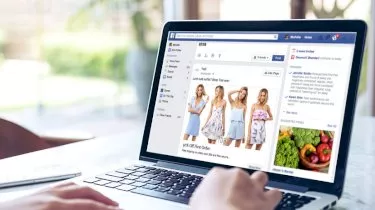Save
Social media a $16bn shopping hole
“Swipe to shop”, “click and collect” and “buy now, pay later” services are burning big holes in the pockets of Australians, with the nation collectively spending more than $16 billion a year on social media shopping.
Social media a $16bn shopping hole
“Swipe to shop”, “click and collect” and “buy now, pay later” services are burning big holes in the pockets of Australians, with the nation collectively spending more than $16 billion a year on social media shopping.

The research from ING has found that more than a third of Australians concede that the ease with which social shopping can be done has led them to make purchases that they otherwise would not have made.
On an individual level, Australians are spending $860 annually, with 3.2 million people admitting to buying something they see on their feed at least once a fortnight.
One in five Australians also said they consider buying something on social media every time they scroll through a social feed, with Facebook crowned as the most popular medium.
Commenting on the data, ING’s head of retail, Melanie Evans, said online shopping is “undoubtedly very convenient”.

“The recent emergence of shopping via social media has made it easier than ever to get what we want, but it’s also easy to unintentionally overspend.”
With 36 per cent of the surveyed respondents agreeing that social media buying opportunities are very targeted to their interests, Ms Evans commented that “it’s a good idea to be aware of the highly targeted advertising often employed by social media platforms, which can increase temptation to buy things we otherwise wouldn’t have considered”.
Over a third (34 per cent) of Australia’s “social shoppers” have conceded that social media makes them more likely to impulse buy.
A similar figure (32 per cent) did express that they would spend less if they didn’t see things that they wanted advertised in their feeds.
“If you are focused on saving, try and avoid those impulse purchases and the buyer’s remorse that can come with them. Spontaneous dips into our hard-earned savings all add up,” Ms Evans outlined.
She also highlighted that ING’s research found “that nearly a quarter of those who shop via social media do not have a spending account separate from their savings account, and a similar number also admit to not keeping track of their online spending”.
But there are tools people can use to avoid overspending, she continued.
“And don’t forget that social spending is often borderless,” Ms Evans reminded.
“Don’t get hit with unnecessary fees – accounts with no international transaction fees are an option for those regularly purchasing from international retailers.”
nestegg has previously questioned whether Afterpay habits are making Aussies poor.
About the author

About the author


Expenses
Expert tips to secure your financial safety net
New Zealanders are known for their "she'll be right" attitude, but when it comes to handling unexpected bills, being prepared is crucial. Read more

Expenses
Australians continue to opt for free VPNs, ignoring potential privacy risks
Australians, alongside citizens of Sweden, South Korea, and Mexico, are increasingly choosing to use free Virtual Private Networks (VPNs), despite the potential threats to their privacy. Read more

Expenses
Rooftop solar in childcare centres could cut energy bills by millions
The analysis conducted by Parents for Climate has revealed that the installation of rooftop solar and batteries in early childhood education and care (ECEC) centres could lead to savings of up to $130 ...Read more

Expenses
Corporate Traveller identifies key strategies for business travel savings
Flight Centre Travel Group's Corporate Traveller, a premier service provider for managing SME travel, has shared several effective strategies that enabled their business clients to significantly ...Read more

Expenses
Price no longer the prime factor for energy bills
Many Australians are intrigued but unconvinced when it comes to greening their energy bill. Read more

Expenses
1 in 2 Aussie pet owners spends on their pets more than themselves
Does owning a pet eat into your monthly budget? You’re not alone. Read more

Expenses
The real reason Sydney’s petrol prices are so high
Sydney fuel prices may seem like they’re soaring, but a recent study indicates that they may be cheaper than you think. Read more

Expenses
Morrison backs big pharma, turns back to developing countries
Big pharma is currently fighting to maintain intellectual property protections over COVID-19 vaccines, with Australia refusing to act despite having no pharmaceutical companies. Read more

Expenses
Expert tips to secure your financial safety net
New Zealanders are known for their "she'll be right" attitude, but when it comes to handling unexpected bills, being prepared is crucial. Read more

Expenses
Australians continue to opt for free VPNs, ignoring potential privacy risks
Australians, alongside citizens of Sweden, South Korea, and Mexico, are increasingly choosing to use free Virtual Private Networks (VPNs), despite the potential threats to their privacy. Read more

Expenses
Rooftop solar in childcare centres could cut energy bills by millions
The analysis conducted by Parents for Climate has revealed that the installation of rooftop solar and batteries in early childhood education and care (ECEC) centres could lead to savings of up to $130 ...Read more

Expenses
Corporate Traveller identifies key strategies for business travel savings
Flight Centre Travel Group's Corporate Traveller, a premier service provider for managing SME travel, has shared several effective strategies that enabled their business clients to significantly ...Read more

Expenses
Price no longer the prime factor for energy bills
Many Australians are intrigued but unconvinced when it comes to greening their energy bill. Read more

Expenses
1 in 2 Aussie pet owners spends on their pets more than themselves
Does owning a pet eat into your monthly budget? You’re not alone. Read more

Expenses
The real reason Sydney’s petrol prices are so high
Sydney fuel prices may seem like they’re soaring, but a recent study indicates that they may be cheaper than you think. Read more

Expenses
Morrison backs big pharma, turns back to developing countries
Big pharma is currently fighting to maintain intellectual property protections over COVID-19 vaccines, with Australia refusing to act despite having no pharmaceutical companies. Read more













